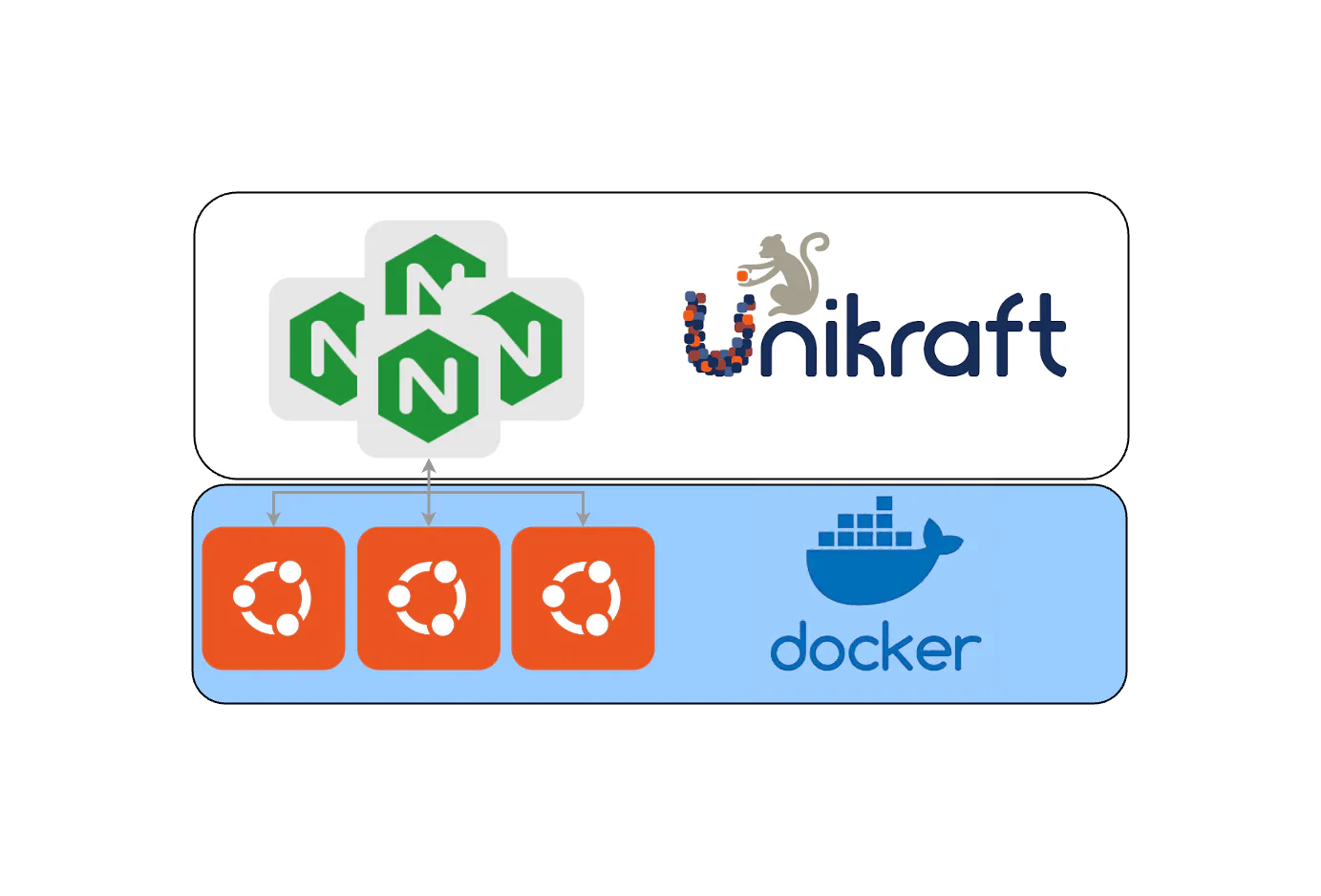Nginx Unikernel Deployment

Unikernels within Oakestra
This guide is (almost) a clone of the containers Nginx client-server applications described in previous walkthrough, however, we instead use Unikraft Nginx server.
We can deploy Nginx using Unikraft. This will allow us to have a more lightweight and isolated version of Nginx for the machines supporting unikernel virtualization.
Unikraft Runtime
To enable unikernel support, please refer to the Unikernel Support manual section.
SLA Template
We create a service named curl using a curlimages/curl:7.82.0 docker image. This service performs a curl request to an Oakestra semantic IP address of our choice (10.30.30.31), and then it fails. After failure, Oakestra will re-deploy the instance indefinitely.
Together with the curlv4 service, we deploy a Nginx service named nginx using the nginx_amd64.tar.gz Unikraft image hosted online. This service will be assigned a Round-Robin semantic IPv4 address 10.30.30.31. Since this kernel image is only available for amd64 architecture, we specify this in the SLA template using "arch": ["amd64"], selector.
Oakestra Networking
To find out more about networking, please refer to the Networking section.
Refer to the following SLA template to deploy the services.
{
"sla_version": "v2.0",
"customerID": "Admin",
"applications": [
{
"applicationID": "",
"application_name": "clientsrvr",
"application_namespace": "test",
"application_desc": "Simple demo with curl client and Nginx server",
"microservices": [
{
"microserviceID": "",
"microservice_name": "nginx",
"microservice_namespace": "nginx",
"virtualization": "unikernel",
"cmd": [
""
],
"memory": 400,
"vcpus": 1,
"vgpus": 0,
"vtpus": 0,
"bandwidth_in": 0,
"bandwidth_out": 0,
"port": "9000:80",
"storage": 0,
"code": "https://github.com/oakestra/oakestra/releases/download/alpha-v0.4.301/nginx_amd64.tar.gz",
"arch": [
"amd64"
],
"state": "",
"addresses": {
"rr_ip": "10.30.30.31"
},
"added_files": []
},
{
"microserviceID": "",
"microservice_name": "curl",
"microservice_namespace": "nginx",
"virtualization": "container",
"cmd": [
"sh",
"-c",
"curl 10.30.30.31 ; sleep 15"
],
"memory": 100,
"vcpus": 1,
"vgpus": 0,
"vtpus": 0,
"bandwidth_in": 0,
"bandwidth_out": 0,
"storage": 0,
"code": "docker.io/curlimages/curl:7.82.0",
"state": "",
"port": "",
"added_files": []
}
]
}
]
}Oakestra CLI Tool
In this guide we’ll use the comprehensive Oakestra CLI toolkit to interact with the Oakestra-managed infrastructure.
Get Started with the Oakestra CLI
Check out how to deploy your first application with the CLI.
You can check if `oak-cli` is installed by running the following command:
oak vLet’s deploy the services
oak a c --sla-file-name unikernel-nginx-client-server.json -dDid you know?
If your SLA file is not in the ~/oak_cli/SLAs directory you can use the following command instead:
oak a c --sla-file-name $(pwd)/unikernel-nginx-client-server.json -dNow the curl service will perform a curl request to nginx, then it will fail. Oakestra will re-deploy a new instance, and so the cycle will continue.
Scale up the Nginx service
Let’s fetch the Nginx’s Service ID using
oak s sThen let’s deploy a second Nginx instance using:
oak s d <Nginx Service's ID>By running oak s s you should now see two instances of the Nginx service running.
╭──────────────┬──────────────────────────┬────────────────┬────────────┬──────────────────────────╮
│ Service Name │ Service ID │ Instances │ App Name │ App ID │
├──────────────┼──────────────────────────┼────────────────┼────────────┼──────────────────────────┤
│ curl │ 672cf97ff7728660d15a584d │ 0 RUNNING ● │ clientsrvr │ 672cf97fa3ba9aac11ea11af │
├──────────────┼──────────────────────────┼────────────────┼────────────┼──────────────────────────┤
│ │ │ 0 RUNNING ● │ │ │
│ nginx │ 672cf97ff7728660d15a5852 │ │ clientsrvr │ 672cf97fa3ba9aac11ea11af │
│ │ │ 1 RUNNING ● │ │ │
╰──────────────┴──────────────────────────┴────────────────┴────────────┴──────────────────────────╯Sit down, relax, and watch the magic happen 🪄
Use the following command to check the instance’s logs:
oak s i <Nginx Service ID>You’ll see the nginx logs of both instances, and the effects of the resulting balancing.
For this example we used the command oak s i 672cf97ff7728660d15a5852
╭───────────────────────────────────────────────────────────────────────────────────────────────╮
│ name: nginx | NODE_SCHEDULED | app name: clientsrvr | app ID: 672cf97fa3ba9aac11ea11af │
├───────────────────────────────────────────────────────────────────────────────────────────────┤
│ 0 | RUNNING ● | public IP: 131.159.24.51 | cluster ID: 672cf976f7728660d15a583e | Logs : │
├───────────────────────────────────────────────────────────────────────────────────────────────┤
│ 10.30.0.2 - - [07/Nov/2024:17:41:04 +0000] "GET / HTTP/1.1" 200 615 "-" "curl/7.82.0-DEV" "-" │
│ 10.30.0.2 - - [07/Nov/2024:17:41:34 +0000] "GET / HTTP/1.1" 200 615 "-" "curl/7.82.0-DEV" "-" │
├───────────────────────────────────────────────────────────────────────────────────────────────┤
│ 1 | RUNNING ● | public IP: 131.159.24.51 | cluster ID: 672cf976f7728660d15a583e | Logs : │
├───────────────────────────────────────────────────────────────────────────────────────────────┤
│ 10.30.0.2 - - [07/Nov/2024:17:37:34 +0000] "GET / HTTP/1.1" 200 615 "-" "curl/7.82.0-DEV" "-" │
│ 10.30.0.2 - - [07/Nov/2024:17:41:19 +0000] "GET / HTTP/1.1" 200 615 "-" "curl/7.82.0-DEV" "-" │
╰───────────────────────────────────────────────────────────────────────────────────────────────╯As you can see both instances got requests from the single client we have, even is the client is always using the same IP address.
